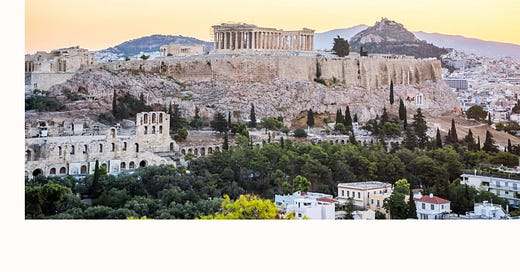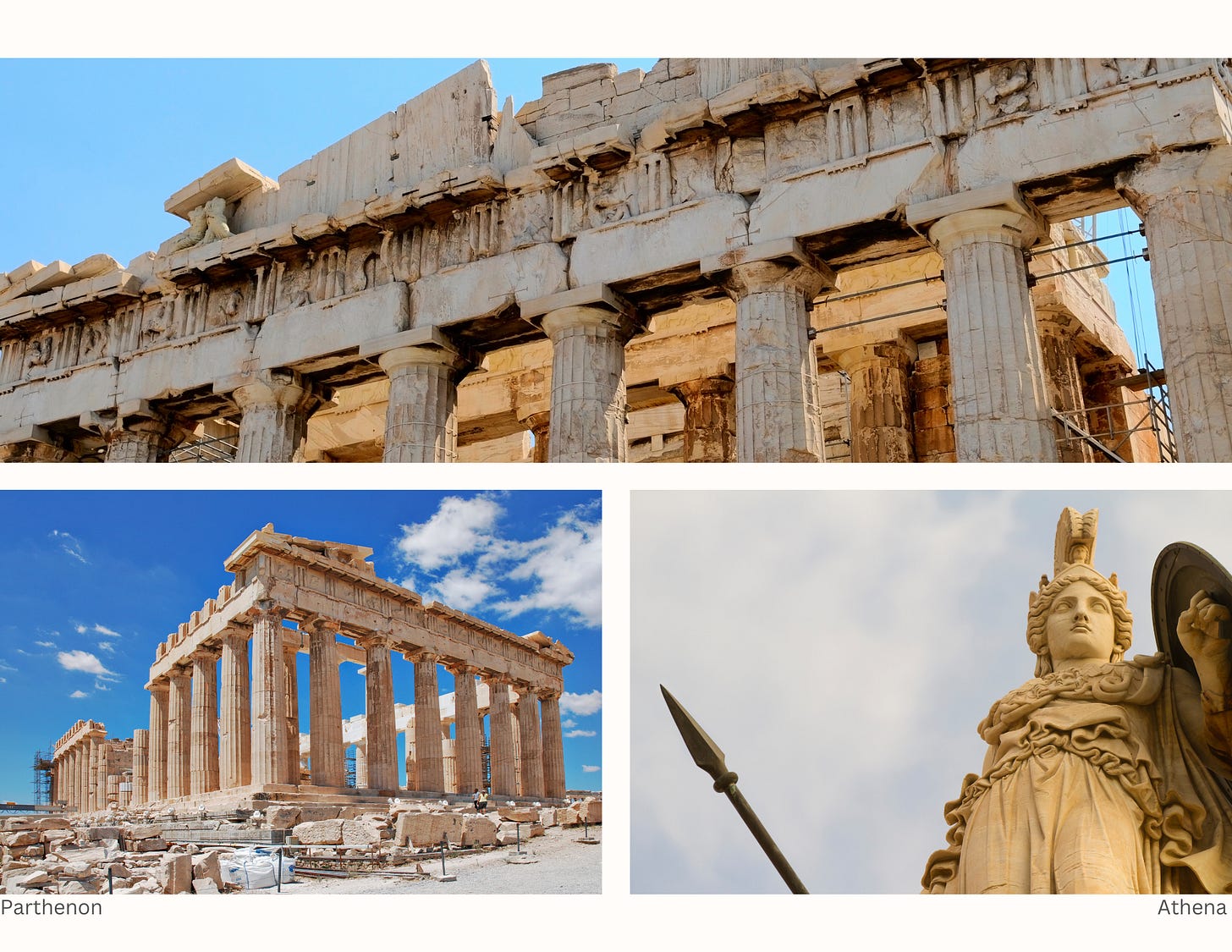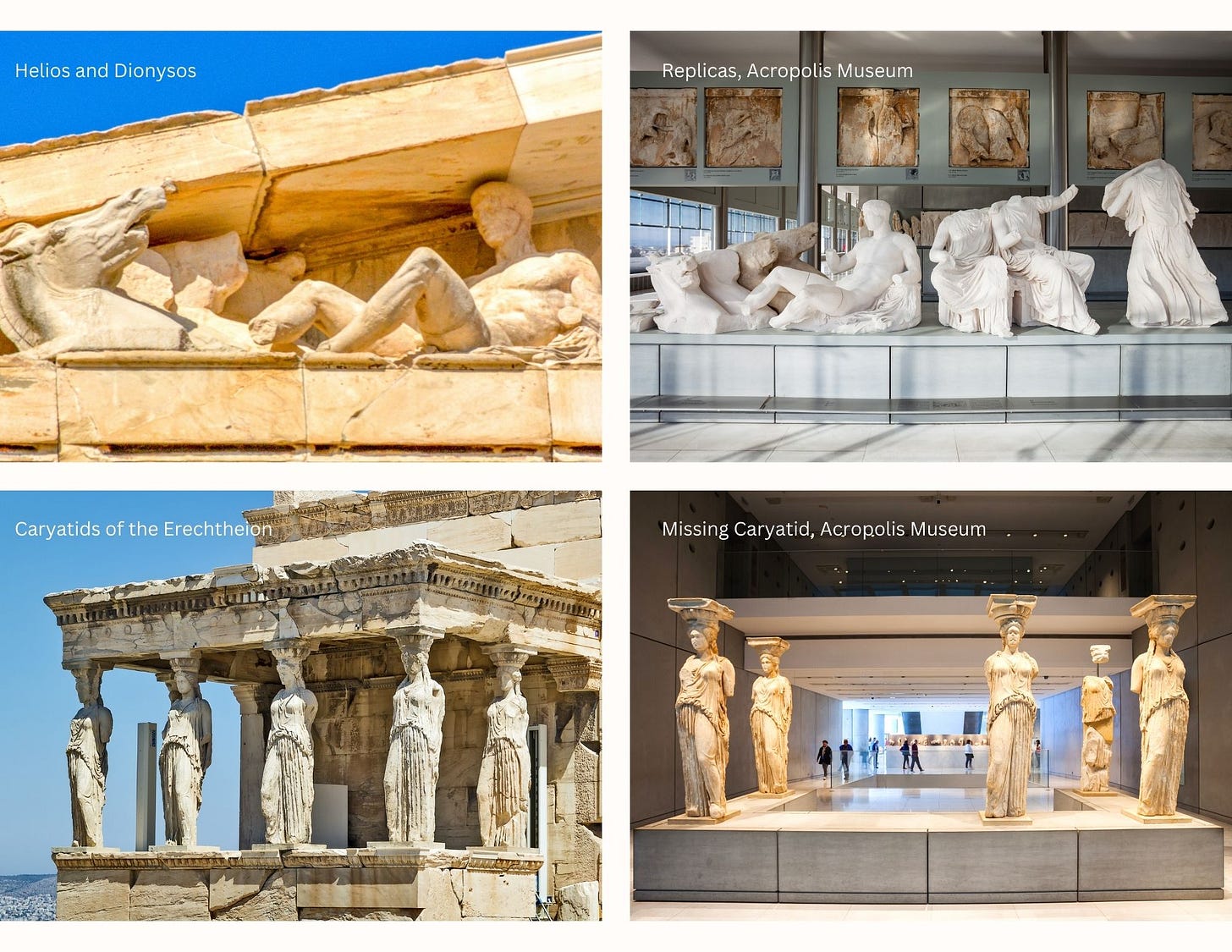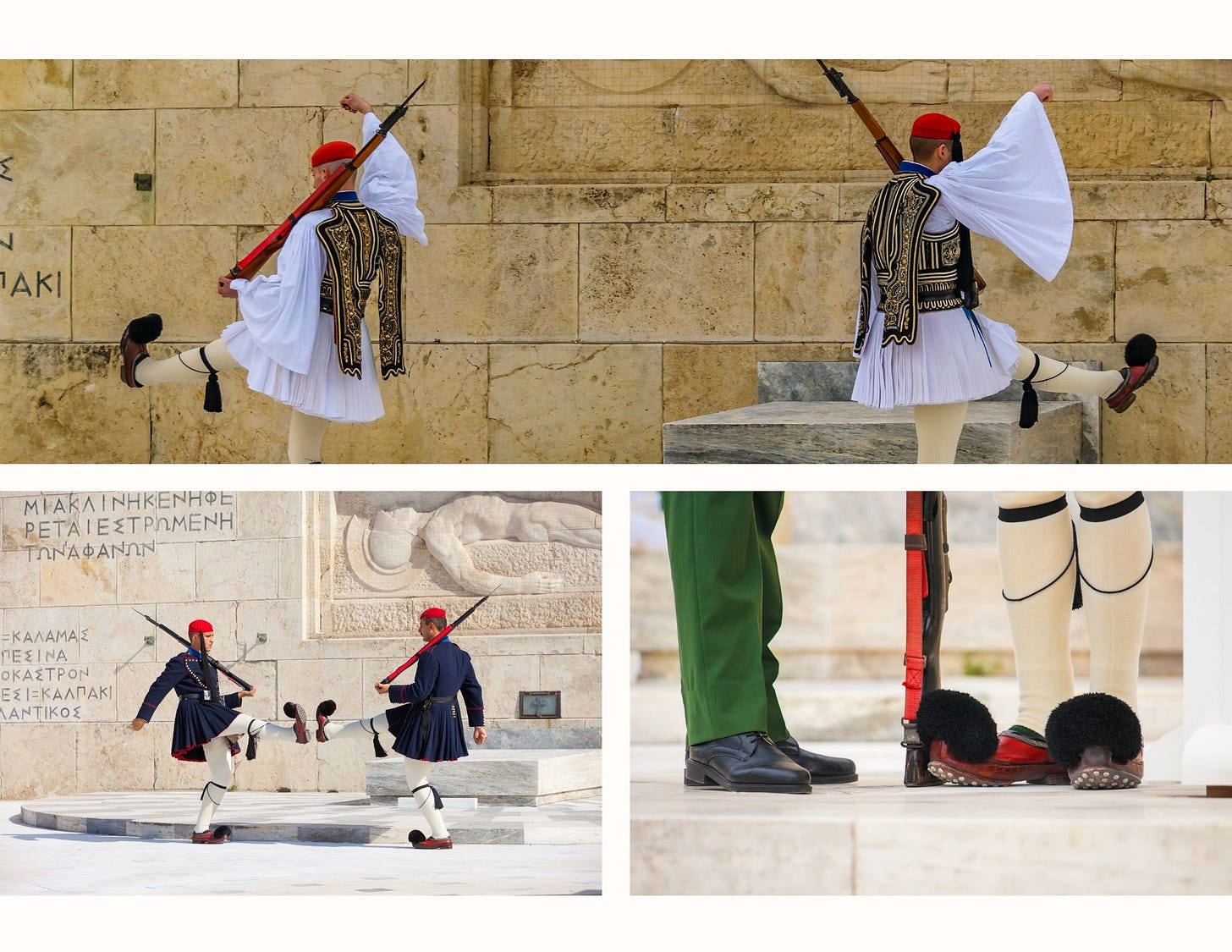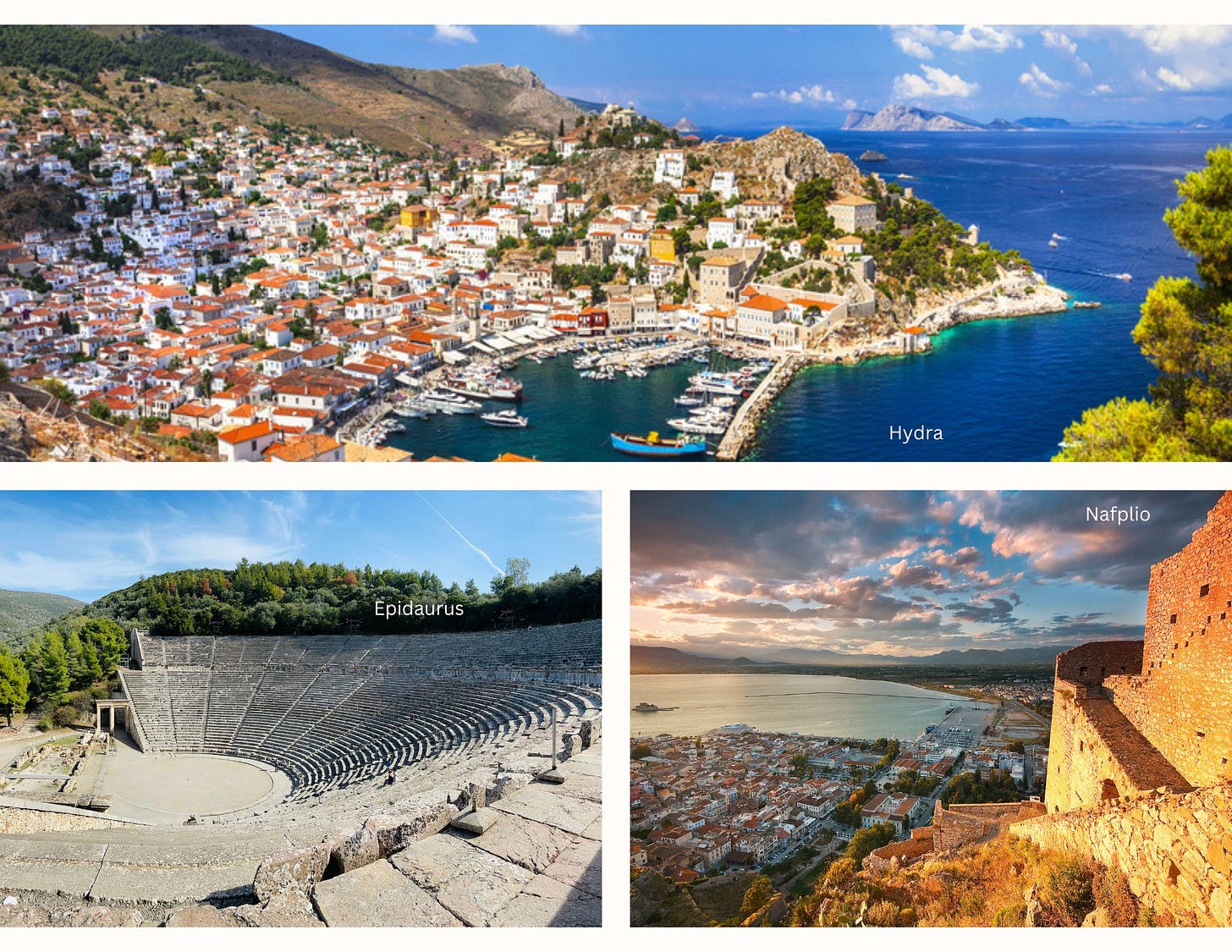Athens
Surprising foodie haven, an unbeatable Airbnb selection and value - here are our best finds!
You’re receiving this email as a subscriber to A Voyagist Newsletter. Thank you!! If you know someone who may enjoy it, please pass it along!
Some call it the birthplace of democracy, where western civilization began. Some called it a cesspool of pollution in the late 70s and 80s. Some things have changed, and some never have. Perhaps the real surprise is just how great it is today.
With 3,400 years of recorded history, it was where Plato's Academy and Aristotle's Lyceum were founded. One man, one vote, and one-year term limits for politicians were the rules 2,500 years ago! It is the smallest of the big European cities, with a population of nearly 3 million today, around 35% of all of Greece. The industrial and traffic-sourced pollution were infamous due in part to being surrounded by four mountains, creating an atmospheric temperature inversion holding the smog in, like Los Angeles or Mexico City. Those issues were corrected in the 90s, and blue skies prevail today. Well, mostly, anyway. Like many European countries, they had some terrible forest fires last year. In fact, in 2021, Athens appointed a Chief Heat Officer to help the capital city cope with the extreme heat due to climate change.
Athens gets its name from the goddess Athena, the city's patron. Then again, some think the goddess took Athens's name. She beat out Poseidon in a contest for naming rights, winning by giving the city the first olive tree. Since 1834, it has been the capital of Greece (Nafplio was the first capital in 1829, more on that wonderful town in another post). Despite its lofty heritage, Athens was at war as a city-state for thousands of years, conquered by Persians, Spartans, Romans, Venetians, Ottomans, and finally, the Germans in 1941. The thing is, today, Athens gets it. Industry has long been moved out of town, curbing pollution, and you will also notice the distinct lack of high rises. That is because of building height restrictions where nothing is to obscure a clear view of the Acropolis. They know that beauty shots are their money maker. And it is finally getting its financial house in order, with a steady government who have gone a long way to pay down the country's crippling debt.
For some, Athens has been not much more than a one-day jumping-off point to the beautiful Greek islands. That's too bad. While a full-size city, it is not big by most definitions. It is easy to get around, and that’s good as there is much to see and easily done in 5 days or less, depending on how ambitious you are.
The Must-Sees
Any place 5,000 years old has more than its share of temples, ruins, museums, and palaces. However, for your five days or so, here are the places not to be missed.
The Acropolis. Number one on everyone's list and visible from all over Athens. There has been something up there for many thousands of years, but what you see today is largely the work of Pericles from around 468 BC. The Parthenon, the Erechtheion, and the Temple of Athena all date from this time. In 1687, the Acropolis was used to store gunpowder, and a Venetian shell blew up a large part of it. It has been restored many times since, often badly. And it is being restored again, this time correctly, as we speak. The current work began in 1975 and included collecting all the pieces, even small ones, and reconstructing them like a jigsaw puzzle - 2,675 tons of it! What couldn't be re-built was supplemented by new marble from Mount Pentelicus, from which all the original marble was sourced. The now-repaired columns of the Parthenon are constructed in round sections, held together by wooden dowels, and are now all replaced with titanium.
Tip: Get a guide as the history is better related by them than wandering with a guidebook. Be sure to wear good shoes as there is climbing involved and a hat. It gets hot up there in the warm months. Bring water too.
The Parthenon and the Statue of Athena. Once conceived as a temple celebrating the victory over the Persians, its builder Pericles saw it as more like a treasury. The 12-meter-tall statue of Athena inside was covered in gold plates that could be removed when needed and replaced (with interest). There was the equivalent of forty talents of gold, 2,276 pounds of gold in today's measure—a pretty decent bank. The statue was rumoured to have been taken to Constantinople by the Ottoman invaders, the gold taken, and the statue destroyed.
Tip: Where available, we always take a Hop-On, Hop-Off Bus tour to get oriented in a new city. They are an easy, hassle-free way to see all the top attractions in a city, and in some cities, the in-person guides (like the ones in London) are very entertaining. Otherwise, there are free audio guides in multiple languages. Board the bus from any designated stops, hop off at the attraction you want to visit and simply hop back on the next bus when you want to continue. We usually sit on the bus for the entire loop and enjoy panoramic city views as we get our bearings.
The Acropolis Museum. For many years there was a small museum next to the Parthenon. Too small. A new museum, opened in 2009, is built on ruins that can be seen through the glass floor. But it was also made for a more noble purpose. From 1801-1812, Lord Elgin removed about half of the surviving sculptures from the Parthenon and from the Erichtheion and the Propylaea (the monumental gateway or entrance to the Acropolis). It is said he obtained a Firman, a permit for their removal from the Ottoman occupiers of Greece. These people kept meticulous records, and no Firman had ever been found.
The Acropolis Museum is the one must-see attraction to visit with the Parthenon.
Lord Byron called Elgin a vandal and a looter. Elgin sold the sculptures to the British Museum in 1816, and to this day, the Museum has refused to return them. One of their arguments against the return was there was no proper space to display them. Well, there is now, and it has been there since 2009. The new Museum is a gorgeous, tranquil place containing hundreds of beautiful pieces. That includes 5 of the six original Caryatids, the statuary columns carved as maidens that held up the Erechtheion. What is there in place now are reproductions. The originals, five of them, were meticulously restored by laser light. There is an empty space for the 6th sister, also stolen by Elgin and sitting alone in the British Museum. Be sure to go to the top floor, where The Parthenon Gallery has the identical orientation and dimensions as the original from the floor-to-ceiling windows. The remaining Friezes not stolen by Elgin are on display with empty spaces waiting for completion with the return of what Lord Elgin looted.
The renowned Caryatids in the Acropolis Museum. The figures were originally six, but one was removed by Lord Elgin in the early 19th century and is now in the British Museum in London. The pedestal for the Caryatid removed to London (second from the left on the front) remains empty.
The Plaka and Anafiotika. Loosely translated as Old Athens, The Plaka has been continuously inhabited since antiquity. It is a maze of narrow streets holding shops, cafes, and restaurants on the northeastern slope of The Acropolis. Abandoned during the Greek War of Independence in 1826 due to the many battles held there, The Plaka was gradually repopulated. Very touristy but still charming, it is the only neighbourhood in Athens where all utilities are underground in custom-made tunnels.
At the top of The Plaka is the little area of housing called Anafiotika. It was where construction workers lived; carpenters, stone and marble workers who built King Otto's palace in 1843. Since the 1970s, the state bought 45 standing houses; they are now leased, and many are rented out as Airbnbs. We stayed in one on our last visit.
Dimotiki Agora. Nicknamed the city's stomach, also known as the Varvakios Agora, this has been the public market of Athens since 1886. It is a feast for the senses, all of them. The fish market is in the center, and you will find almost every kind of sea creature imaginable; 5-10 tons of fish land here daily, making it the largest fresh fish market in Europe. Surrounding the market on three sides is the meat market. Most things you will recognize, some you will not; beef, pork, lamb, goat, chickens, rabbits, and tables full of organs of every kind for stews and who knows what. There are butchers here who have had stalls in their families for 100 years.
For a glimpse of Athenian life, wander and don’t miss Varvakios Agora and its surrounding streets.
Across Athinas Street is the open fruit and vegetable market, and the surrounding streets have shops that sell nothing but eggs or sausages or olives. On Evripidou Street, you will find one of the most diverse shopping experiences imaginable. Plant stores, seed stores, and sausage shops are all side by side for a whole city block. And there are restaurants, lots of them.
The Evzones. These are the ceremonial guards who parade in front of the Presidential Palace and the Tomb of the Unknown Soldier, which is in front of the Greek Parliament buildings at the top of Syntagma Square. OK, they dress funny, but these are serious, disciplined soldiers, the elite. Yes, they wear a white dress over white leggings. Called the Fustanella, the skirt has 400 pleats, one for every year of the Ottoman occupation. Yes, they have a big black pompom on the toes of their boots. It hides a sharpened blade. Their boots, the Tsarouchi, weighs 5.5 pounds each as they have 60 nails in the sole and heel that are stomped and slid, mimicking the sound of horses' hooves, or some say rifle fire. As they parade high-stepping to their positions, they do not speak. Always accompanied by a commander in standard military uniform, they answer yes with one blink, no with two blinks, and don't know with three blinks. Check out the times of their parade in the itinerary below. It is a fascinating show.
Mon-Sun top of every hour for change-outs. Sundays at 11:00 am, the Grand Changing of the Guard Ceremony
OK, these are the Must-Sees in our opinion. However, there is so much more. The National Archaeological Museum on Patisson Street is one of the best in the world. When you wander through The Plaka, don’t miss Mnisikleous Street, famous for its restaurant staircase. At night, this pedestrianized street comes alive with music. It is popular with locals, who stop by in the early evening for mezes and ouzo. The Agora and the adjacent Roman Agora were where government and commerce were conducted in ancient times and an easy walk to or from the Plaka. The Temple of Zeus here was even bigger than the Parthenon but was left unfinished from the 2nd century until the Roman Emperor Hadrian finished it in the 6th century. 400 years later! It then had 100 giant columns; there are 15 left standing today. Hadrian loved Athens and was more its benefactor than its conqueror. You can’t miss seeing Hadrian’s Arch at the entrance. On one side, facing the Acropolis, an inscription reads: “This is Athens, the ancient city of Theseus.” On the other side, facing The Temple of Zeus, the inscription reads: “This is the city of Hadrian, and not of Theseus.” It was then the dividing line between ancient Athens and new Athens. Well, relatively new since it was built in 132 AD. Finally, you can’t miss seeing Mount Lycabettus. It is the highest point in Athens at nearly 1,000 feet above sea level. You can walk up if you are super fit or take the funicular to the top where there is a restaurant, a theater, and a view over all of Athens. However, given there are no high rises, this isn’t a New York cityscape, and all you can really see of note is the Acropolis. Just saying.
Tip: If you’re lucky enough to visit Athens between June and October during the annual Athens Festival, for a truly unforgettable, once-in-a-lifetime experience, be sure to attend a performance at one of the world’s oldest and finest open-air theaters, the Odeon of Herodotus Atticus. Maria Callas, Frank Sinatra, Luciano Pavarotti, Sting, Elton John, Andrea Bocelli, and many other artists have all performed here. Have a look at their website for what’s on and tickets. www.viagogo.com/Athens/Odeon-of-Herodes-Atticus-Tickets/_V-11530
The stairs leading to your seats are very steep. Depending on where you are seated, you should expect quite a walk-up. Comfortable flat shoes are highly recommended, and the theater has a no-heels policy. Also, the seats are made of stone/marble and are pretty uncomfortable. Bring a wrap or something to sit on.
Tip: For something a little different, check out one of Athen’s cherished institutions - a cinema under the stars. Most are open between May and late September, depending on the weather. Every neighbourhood has at least one open-air movie house. Check out this one near the Acropolis. https://cine-thisio.gr/en/about-us
Where to stay
On my first visit to Athens in 1972, I sat in Syntagma Square, watching the ladies in long black dresses depart their Mercedes limos and enter the Grand Bretagne Hotel. Built in 1842 as a private residence, it was converted into a hotel in 1874. The original mansion was demolished in 1957, and a new wing was built in its place. It was the German headquarters during their occupation in 1941 and the British headquarters when they liberated Athens in 1944. It is a lovely old pile and the signature hotel of Athens. There are other international brands now, but; this is THE place to stay if it’s your first trip to Athens. I love their rooftop restaurant and terrace for their excellent food and views of the square below and the Acropolis. That view is always interesting as you can pretty much count on a protest in front of Parliament. The Athenians love their protests, and while the daytime ones are pretty benign, the ones at night can get rather rowdy. The Grand Bretagne Roof Garden is above the tear gas (mostly). Next door is King George which some friends prefer. Built in 1930, it also has a stunning restaurant on the 7th floor called Tudor Hall with a terrace looking toward the Acropolis. Sense a theme here? Every place has a view of the Acropolis as there are no high rises allowed to block the view.
These are two classic, expensive luxury hotels. Athens has many alternatives, old and new, at much more reasonable pricing. See our Black Book for our picks.
On our first visits to any city, we typically stay at a hotel where we lean on the hotel concierge to guide us and make reservations for meals and transportation. On subsequent visits, as we are more familiar with the city, we venture out to rent Airbnb.
We have found more great Airbnb’s in Athens than in any other city, and at very reasonable prices.
Eating in Athens
People don’t give enough credit to the Greeks for their outstanding and often innovative food. Yes, I know, the ubiquitous Greek Salad is on every menu, and I think we had one every meal, but there is everything here from Michelin starred and recommended to fantastic street food. Try to avoid overtly touristy places as they are average and overpriced. Dig a little deeper, and there are many, many wonderful spots for every budget with carefully prepared food and staff who really care.
And the cost? You will be pleasantly surprised that even in the better restaurants, and let's not kid ourselves, there are hundreds, and they aren't all good; your bill for food, wine, and beer will be much less than you expected. Lovely.
Side Trips
While Athens is more than great for a stand-alone visit, many will continue to use it as a jumping-off spot for the Greek Islands. Fair enough, you have some amazing options a stone’s throw away. While Santorini, Crete, or Paros may tempt you, don’t forget about Hydra. It is a charmer and just a short ferry ride. Quiet, no motorbikes or cars, just the harbor, really. Leonard Cohen loved it there, and so will you. Then, just 90 minutes drive out of Athens, is the gorgeous village of Nafplio, with the ancient ruins of Mycenae and Epidaurus a short drive away. On the way from Athens is the remarkable Corinth Canal, hand dug with over a thousand years of history, 4.6 KM long and only 25 meters wide but with rock walls 90 meters tall. Then there is Delphi, home to the famous oracle, The Temple of Poseidon, with its incredible views of the Aegean Sea, and ancient Olympia, home of the first Olympic Games. Each of these places is accessible for a day trip.
Greece as home?
Greece was pretty much broke for years. Their EU membership allowed them to borrow money and accumulate debt almost impossible to service. And Greeks don't like paying taxes, so they largely didn't. Prime Minister Mitsotakis defeated the austerity government of Tspiris in 2019, and he and his cabinet appear to be proper stewards of the country's finances; plus, Greeks are paying taxes now. We are always looking for the next place we would like to live in after 16 years in Asia. I actually wrote a book about retirement in Southeast Asia, but, like many of our friends, there comes a point where Europe has an appeal. We have done our due diligence in Portugal and Spain. However, there, and in Italy and France, the cost of visas, taxes, and crippling bureaucracy eliminate those options for us. Greece has a retirement visa program similar to Malaysia but relies on property purchase versus fixed deposit. For a 250,000 Euro property purchase, you get a 5-year, renewable residency, no tax on foreign-sourced income, and access to 26 EU countries which is a big plus. You have to factor in the brutal 24% VAT, the highest in Europe, but maybe they can fix that too. It is a place to consider.
This is the Athens we love. Fantastic history, wonderful food, and by any comparison, very reasonably priced. Yes, go to the islands but give yourself a treat and linger in Athens for a day or two or five. It is worth it.
(Last visited March 2022)

